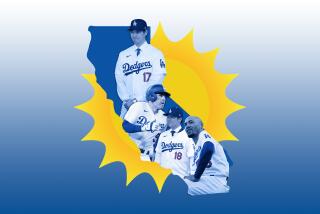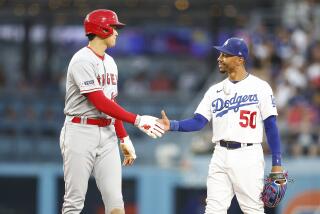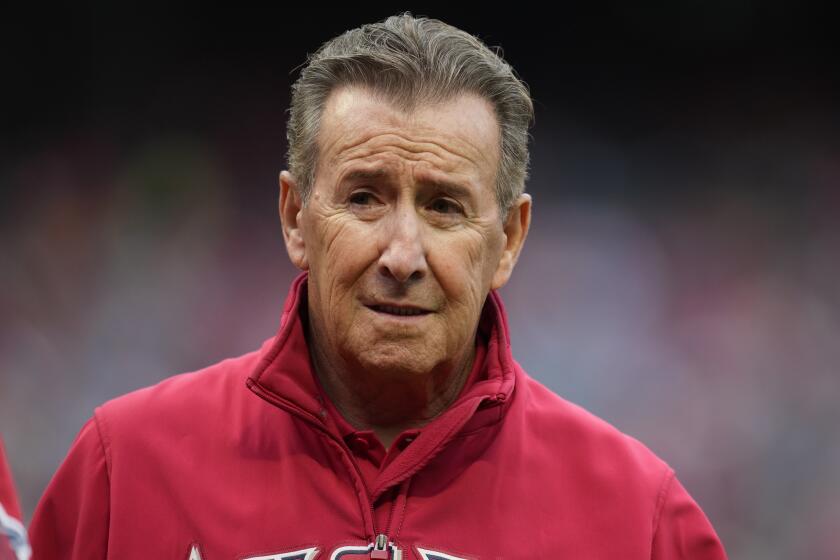With Tommy John, Nothing’s Changed, Except Uniform
OAKLAND — It’s more than 3 1/2 hours before game time, and the first two A’s players have wandered onto the field at the Oakland Coliseum to lob a ball back and forth.
Inside the clubhouse, half a dozen players sit in front of their cubicles pulling on their uniforms and talking about anything but baseball.
Tommy John plops down in the rocking chair next to his locker, flicks the sweat off his forehead with his finger and manages a smile.
“Three miles at my 10K pace,” John offers without being asked.
It’s a different clubhouse and a different uniform, but for Tommy John, the song of summer remains the same. It’s a tune he’s been humming for 22 big-league seasons and, at age 42, he figures he’s still too young to stop singing.
Some of his new teammates are nearly half his age, but none has run three miles yet on this day . . . and few will. But then again, few, if any, will be struggling with stirrups and sanitary socks at age 42.
John seems remarkably unchanged from the cherub-faced youth who made his major league debut with the Cleveland Indians in 1963. Two hundred and fifty-eight wins later, he’s got the same physique, the same boyish good looks and the same Indiana twang with the almost-undetectable stammer.
If Ponce de Leon were still alive, he’d take one look at Tommy John and start outfitting another search team.
Has John discovered the next best thing to the Fountain of Youth?
The Angels didn’t think so. Deciding to go with a rookie-laden starting rotation, they released him on June 11.
The A’s aren’t so sure. They signed him 10 days later.
When the doctors told me it might be the end, that really shook me up. It makes you see even more how really short your life in baseball can be. I know when I do have to quit, it’ll be a sad day in my life.
--TOMMY JOHN, July, 1975 There were many who believed John’s career was already over when he made that statement a year after Dr. Frank Jobe had reconstructed John’s left elbow in a surgical procedure never before performed on a pitcher.
Jobe wasn’t making any guarantees, but John never harbored any real doubts. He is the power of positive thinking personified. Who, but T.J. himself, would have believed he’d still be pitching 10 years later?
John is a different pitcher from the one who felt something snap while throwing a sinker to the Expos’ Hal Breeden that fateful July day in 1974. In ways, maybe even a better one.
But even Tommy John will admit that it all has to come to an end someday. And he’ll also admit that he won’t be the first to know.
“The hitters will tell me,” he says, winking.
The A’s knew they’d get the same articulate, disarming, always-chatty Tommy John. The only question was whether they’d get the same Tommy John who has made a career of frustrating muscle-bound power hitters into pulling outside sinkers and grounding to short; the one who nibbles away at the strike zone until hitters want to step out and scream: “Throw something over the plate, you chicken!”
After three starts in the minor league (outings he requested to get back into shape and his first work in the minors since 1964), John made his debut in Oakland green and gold last week. The A’s got what they were looking for--the same old Tommy John. He went six innings, scattered four hits and didn’t allow an earned run.
“Same old Tommy John I’ve been watching for years,” Wes Stock, the A’s pitching coach, said. “Our only concern was his control, and he goes out there and doesn’t walk a soul.”
A’s Manager Jackie Moore was equally impressed. “Looked to me like he’d been in the rotation all year. Same old Tommy John.”
John dislocated the pinky finger on his pitching hand applying a tag in a rundown during the third inning of his second start Friday night. But he isn’t exactly devastated.
“I’ve done it before,” he told the media later. “That finger has always looked a little gnarly. I don’t think it will take long to heal.”
He wouldn’t even discount the possibility of making his next regular start Wednesday.
If you’re going to bet on somebody, you might as well bet on somebody special ... and Tommy John is somebody special.
--GENE MAUCH, July 31, 1985 Gene Mauch was sitting in the visitor’s dugout, watching Tommy John throw on the sidelines, under the watchful eye of his new manager, when he made the July 31 statement. A rather strange remark for a man who had let John go, putting all his chips on a Kiddie Corps pitching staff that has been struggling of late.
The Angels aren’t the first team to give up on John, though. The Dodgers let him go in 1978 because he wanted a three-year contract and they weren’t sure he’d last that long. The Yankees let him go in 1982 because they figured he was finally through.
The Angels picked him up then and told him to just go out and pitch the way he always had. John won 25 games for the Angels. Now, he’s pitching as he always has--for the A’s.
So, why is T.J. no longer an Angel?
“He just wasn’t happy with his role here,” is Mauch’s only explanation.
That wasn’t exactly the problem, as John sees it. The problem--the way he tells it--was that he had no idea what his role was supposed to be.
“Nobody ever told me what my role was,” John said. “That was the whole problem. That’s why I called all the Angel writers to thank them after I left. Reading the newspapers was the only way I found out anything.
“I finally went to Marcel Lachemann (Angel pitching coach) and said, ‘Is it too much to ask if I’m gonna start, or pitch out of the bullpen? If it’s gonna be 15 days between spot starts, fine, just tell me so I can prepare.’ I’m a guy who believes in and needs proper preparation.
“Lachemann told me he was embarrassed, that he thought Gene had talked to me. Well, no one told me anything. The impression I had was that they were embarrassed to come to a guy who’s pitched as long as I have and say, ‘We don’t think you can help us anymore.’
“Hey, I’m a big boy, just give it to me straight. It’s so simple.”
It wasn’t like John hadn’t seen his departure coming. In fact, he called Angel General Manager Mike Port during the winter and told him that he got the feeling the Angels were going with a youth movement, and fringe veterans with big salaries were in jeopardy.
“Ironically, the whole thing followed the scenario I had mapped out over the winter,” John said. “I’ve seen it happen before. I’ve been on the other side, too, the youngster coming in taking a veteran’s spot.
“But Port laughed and said, ‘No way, Tommy, that’ll never happen.’ ”
John still wasn’t convinced.
“I made a point of going to Palm Springs and talking to Mauch to see what was going to happen,” he said. “Apparently, somewhere between the golf course that day and the start of the season, something happened to change his mind.”
John thinks that Jackie Autry, wife of owner Gene, may have played a pivotal role in that decision, but he’s not going to point any fingers.
“I enjoyed playing for Gene Autry,” John said. “He’s a very nice man. I don’t know why the Angels let me go. The point is they did what they felt they had to do, and I’m not bitter at all about it.”
He might have had reason to be. When the Angels got around to releasing him, the situation was a bit sticky. On the day the Angels decided to put him on the designated-for-assignment list, John was at the UC Irvine Medical Center while his wife, Sally, underwent abdominal surgery.
Port, unable to reach John, called John’s attorney, Bob Cohen, who in turn called John.
John said he felt only “relief,” but when Port called him later at the hospital, it was obvious that Port was making a call he wished he didn’t have to.
“About 20 minutes after Bob called, Port called,” John said. “He said, ‘Well, Tommy, we, uh, felt, uh, that it would be best, uh, for, uh, everyone concerned, uh, if we, uh, put you, uh, on the designated-for-assignment list.’ ”
That meant the Angels had 10 days to assign John to another club via trade or release him.
“That angered me,” John said. “Port had told me all winter that no other club would be interested in a trade because of my contract (which paid him $600,000 this year and $500,000 in 1986), so why would anyone want it now? I said, ‘If you’re just trying to keep me out of baseball as long as possible, you’ve accomplished that.’
“He said he could wait until Sally was out of the hospital to make the move. I told him I wished he’d done it a long time ago.”
After listening to offers from the A’s, Cubs, Yankees, Tigers, Mets and Astros, John chose Oakland because it was a “here’s-the-ball-every-fifth-day situation.”
“They’ve scheduled every day I’m going to pitch,” John said. “That’s all I ever asked for . . . a schedule and a chance to pitch.”
I have no idea why the Angels let him go. I only know why he’s here, to help stabilize this staff ... and take some pressure off me.
--DON SUTTON, 40-year-old A’s pitcher
Stabilize? If you believe John, he’s going to be the A’s savior.
Somewhere between Peralta Hills and Palo Alto, John must have picked up a Nolan Ryan fastball.
“I’m throwing hard these days, too,” John said. “They’ve timed my fastball at 84 miles per hour here, and their radar gun is four or five miles per hour slower than the Angels.”
Tommy John with a 89 m.p.h. fastball?
“If you believe that, I’ve got a bridge I want to sell you,” Mauch said, smiling.
But that’s not really the point. Tommy John thinks he’s a great pitcher and, apparently, that’s a giant step in the right direction.
“At least 75% of pitching is mental,” Stock said. “That’s why he’s still pitching. He knows exactly what he has to do to get people out and he knows he can get them out.”
Moore said: “Experience and success . . . that’s what he offers a club. He’s been on winning clubs, and this time of year, in the heat of battle, he’s the kind of guy who can make good things happen for you.”
Want experience? The A’s have two 40-year-old-plus pitchers and two rocking chairs in the clubhouse. Sutton’s has the inscription “POPS” on the headrest. John’s reads: “GRANPS.”
“GRANPS”?
“You don’t have to know how to spell to play this game,” John says smiling, “ . . . just hit and throw.”
He should know. He was throwing in the big leagues before some of these guys were born.
More to Read
Go beyond the scoreboard
Get the latest on L.A.'s teams in the daily Sports Report newsletter.
You may occasionally receive promotional content from the Los Angeles Times.







